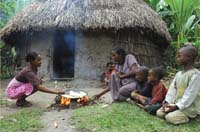Demonstration
In your work as a health educator you will often find yourself giving a demonstration (Figure 10.5). This form of health education is based on learning through observation. There is a difference between knowing how to do something and actually being able to do it. The aim of a demonstration is to help learners become able to do the skills themselves, not just know how to do them.

Can you think of health related things that would be best taught through demonstration?
The whole process of measuring blood pressure, how to use a mosquito net, putting on a condom, giving a child some medicine, etc. can be best illustrated through a demonstration.
You should be able to find ways to make health related demonstrations a pleasant way of sharing skills and knowledge. Although demonstration sessions usually focus on practice — they also involve theoretical teaching as well 'showing how is better than telling how'.
If I hear, I forget
If I see, I remember
If I do, I know.
Chinese proverb
Note that:
- You remember 20% of what you hear
- You remember 50% of what you hear and see
- You remember 90% of what you hear, see and do — with repetition, close to 100% is remembered.
Giving a demonstration
There are four steps to a demonstration:
- Explaining the ideas and skills that you will be demonstrating
- Giving the actual demonstration
- Giving an explanation as you go along, doing one step at a time
- Asking one person to repeat the demonstration and giving everyone a chance to repeat the process (Figure 10.6).

Qualities of a good demonstration
For an effective demonstration you should consider the following features: the demonstration must be realistic, it should fit with the local culture and it should use familiar materials. You will need to arrange to have enough materials for everyone to practice and have adequate space for everyone to see or practice. People need to take enough time for practice and for you to check that everyone has acquired the appropriate skill.
Zahara is a Health Extension Practitioner. She is working in Asendabo kebele. During home visits she educates the families by showing them demonstrations on how to prevent malaria. List at least three features of an effective demonstration that Zahara should follow during her health education activities.
For the demonstration to be effective Zahara should consider the following important points: the materials that she might use and the demonstration process should be real. So, for example, she should have real bed netting with her and at least something she can use that is like a bed. The demonstration should fit with the local culture and she should explain what she is doing as she goes along. She should make sure that there is enough time for at least one person to repeat the demonstration of fitting the bed netting and, if at all possible, for everyone to practice doing it.